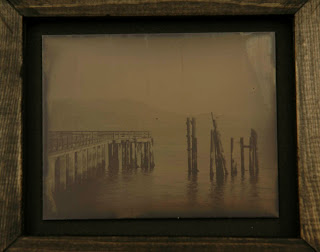Monday, September 22, 2008
Monday, August 11, 2008
Thursday, June 26, 2008
Wednesday, April 16, 2008
Wednesday, March 26, 2008
Kimberly Mowbray
Going to the headlands each week filled me with a sense of wonder. I wanted to capture the serene beauty of the land, but also acknowledge the tension and fear that once surrounded the land.
Until the late 1960’s the Headlands was a military base. It was the counterpart to the Presidio, designed to protect the San Francisco Bay from invasion. This is still very much a part of the land. Bunkers, batteries, and underground concrete buildings, are ghostly remnants of a time past. This is part of the history that I wanted to incorporate into my images. But I sought to look at the legacy of the past through the awe and wonder that the land now embraces.
To go to the Marin Headlands today you will quickly forget how close you are to San Francisco. The gentle rolling hills, sandy beaches and an abundance of wildlife transform your way of thinking. As the fog invades, one is able to see the darker side of the land; the hills seem to retreat in a shroud of mystery. The Headlands force one to submit to the pace of the land. You are forced to slow down and enjoy the moment. My images are a combination of the peaceful solitude that one would encounter today in the headlands, and the memory of the tension and uncertainty that surround its past.
Using a pinhole camera forced me to slow down. This camera is simplistic; there is not a lens, only a pinhole in a piece of metal. The shutter release is reduced to a simple black swinging flap, protecting the tiny hole. Although images created using a pinhole camera are not as sharp as those made by lenses, the camera does not need to be focused. Part of the beauty of the camera is that it is able to focus objects both near and far, in an equal degree of softness.
The negatives were intentionally left uncleared. The texture of the film and how it is recorded on the paper creates conflict as it contrasts with the calmness of the Headlands. The uncleared negatives also help to create the illusion of memory and the passing of time.
This camera fit my process in the Headlands. Each time I went out, I would begin by hiking anywhere from thirty minutes to a few hours. This allowed me to connect with the place. It gave me time to take in the beauty and remoteness of the area. Once I found something that embraced the past and present I would begin the process of photographing it. After setting up my camera, and figuring out my exposure, I would lift the cover that acted as my shutter. Exposure times vary varied from eight seconds to thirty minutes, corresponding to the circumstances of light. This allowed me to experience the moment, suspend time and re-connect.
-Kimberly Mowbray



Until the late 1960’s the Headlands was a military base. It was the counterpart to the Presidio, designed to protect the San Francisco Bay from invasion. This is still very much a part of the land. Bunkers, batteries, and underground concrete buildings, are ghostly remnants of a time past. This is part of the history that I wanted to incorporate into my images. But I sought to look at the legacy of the past through the awe and wonder that the land now embraces.
To go to the Marin Headlands today you will quickly forget how close you are to San Francisco. The gentle rolling hills, sandy beaches and an abundance of wildlife transform your way of thinking. As the fog invades, one is able to see the darker side of the land; the hills seem to retreat in a shroud of mystery. The Headlands force one to submit to the pace of the land. You are forced to slow down and enjoy the moment. My images are a combination of the peaceful solitude that one would encounter today in the headlands, and the memory of the tension and uncertainty that surround its past.
Using a pinhole camera forced me to slow down. This camera is simplistic; there is not a lens, only a pinhole in a piece of metal. The shutter release is reduced to a simple black swinging flap, protecting the tiny hole. Although images created using a pinhole camera are not as sharp as those made by lenses, the camera does not need to be focused. Part of the beauty of the camera is that it is able to focus objects both near and far, in an equal degree of softness.
The negatives were intentionally left uncleared. The texture of the film and how it is recorded on the paper creates conflict as it contrasts with the calmness of the Headlands. The uncleared negatives also help to create the illusion of memory and the passing of time.
This camera fit my process in the Headlands. Each time I went out, I would begin by hiking anywhere from thirty minutes to a few hours. This allowed me to connect with the place. It gave me time to take in the beauty and remoteness of the area. Once I found something that embraced the past and present I would begin the process of photographing it. After setting up my camera, and figuring out my exposure, I would lift the cover that acted as my shutter. Exposure times vary varied from eight seconds to thirty minutes, corresponding to the circumstances of light. This allowed me to experience the moment, suspend time and re-connect.
-Kimberly Mowbray



Subscribe to:
Comments (Atom)
















































